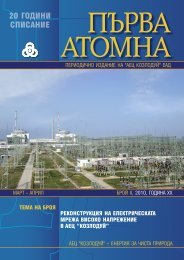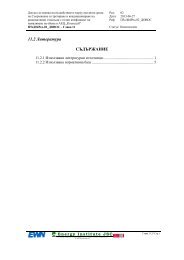Summary Report for Conduct of Kozloduy NPP Stress Tests
Summary Report for Conduct of Kozloduy NPP Stress Tests
Summary Report for Conduct of Kozloduy NPP Stress Tests
You also want an ePaper? Increase the reach of your titles
YUMPU automatically turns print PDFs into web optimized ePapers that Google loves.
“<strong>Kozloduy</strong> <strong>NPP</strong>” PLC<br />
SUMMARY REPORT<br />
<strong>for</strong> <strong>Conduct</strong> <strong>of</strong> <strong>Kozloduy</strong> <strong>NPP</strong><br />
<strong>Stress</strong> <strong>Tests</strong><br />
occur in their structures at extreme wind. In this case, if the spray pool makeup pumps are damaged,<br />
it is running emergency makeup <strong>of</strong> the pools <strong>of</strong> 6. ShPS in the valley <strong>of</strong> Danube River, i.e. the<br />
safety functions are not violated.<br />
Given that the structure <strong>of</strong> the buildings DGS is rein<strong>for</strong>ced concrete ("heavy"), it can be<br />
assumed that at calculation and sizing <strong>of</strong> the combinations <strong>for</strong> seismic impact.. There<strong>for</strong>e, the<br />
structure can accommodate the calculated ef<strong>for</strong>t under extreme wind pressure, which are close and<br />
lower than those at a seismic impact.<br />
4.3.2.1.5 Spray pools Units 5, 6<br />
The design basis <strong>of</strong> spray pools are consistent with their 1 category seismic resistance and<br />
the estimated maximum wind speed at probability p = 0.01% (once per 10,000 years) <strong>of</strong> 45 m/s.),<br />
which meets the requirements set <strong>for</strong> normative and extreme wind speeds.<br />
Supplementary water <strong>for</strong> spray pools, which comes from pumps CPS-3 and CPS-4 and as a<br />
reserve - diesel pumps and ShPS, compensates <strong>for</strong> losses from spraying at weak and moderate<br />
winds. There is a process option at extremely strong winds to eliminate losses from blowing, the<br />
water supplied <strong>for</strong> cooling is released directly to the bottom <strong>of</strong> the spray pools without spraying in<br />
nozzles, as its cooling is by convection.<br />
4.3.2.2 Snowfalls<br />
4.3.2.2.1 Main building – Reactor compartment Units 5 and 6<br />
The calculated value <strong>of</strong> snow load (2,52 kN /m2 ) is 50% higher than the applicable<br />
standards (1,68 kN/m2) and 57% higher that the extreme value <strong>of</strong> snow load (1.6 kN/m2). The<br />
structure has reliable stiffness and can withstand extreme snowfall.<br />
4.3.2.2.2 Rein<strong>for</strong>ced concrete ventilation pipe<br />
loads.<br />
Due to the structure <strong>of</strong> the ventilation pipes they are not threatened by damage from snow<br />
4.3.2.2.3 CPS 3 AND CPS 4, DGS-1,2 and 3 cells<br />
The calculated value <strong>of</strong> snow load in the design basis <strong>of</strong> the buildings (0,98 кN/м2) is lower<br />
than the current standards (1,68 КN/м2) and extreme value (1.6 kN/м2). At relatively heavy<br />
structures, such as rein<strong>for</strong>ced concrete, with high ratio <strong>of</strong> permanent loads to the snow loads the<br />
impact <strong>of</strong> the snow load increase is minimal. The physical condition <strong>of</strong> structural elements and the<br />
influence <strong>of</strong> a constant load is rather leading to determining the bearing capacity <strong>of</strong> the elements<br />
and determination <strong>of</strong> sections, in which boundary de<strong>for</strong>mation and loss <strong>of</strong> bearing capacity occurs.<br />
The ro<strong>of</strong>s <strong>of</strong> DGS-1,2 and 3 cells have sufficient bearing capacity to accommodate the load<br />
<strong>of</strong> snow according to the new standards.<br />
133/202

















